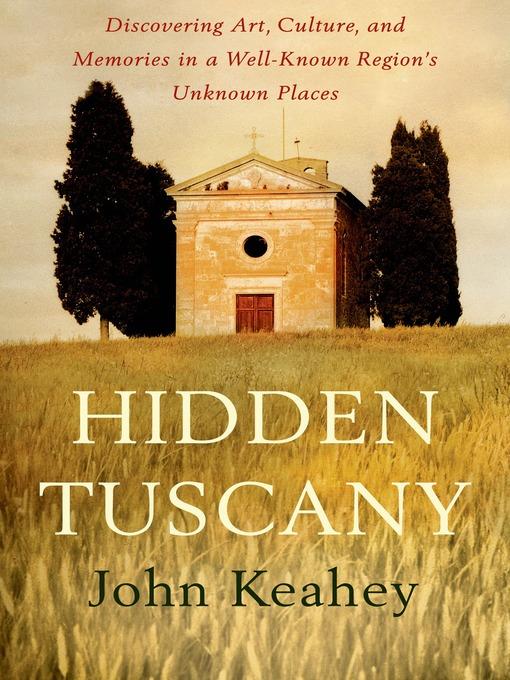
Hidden Tuscany
Discovering Art, Culture, and Memories in a Well-Known Region's Unknown Places
کتاب های مرتبط
- اطلاعات
- نقد و بررسی
- دیدگاه کاربران
نقد و بررسی

June 9, 2014
Travel writer Keahey (Seeking Sicily) delivers another insightful look at the wonders of Italy, this time focusing on the coastal areas of western Tuscany to discover places most Americans “quickly pass through en route to somewhere else.” Keahey focuses his attention on islands and inland villages that have “some of the most spectacular scenery in all of Tuscany.” He explores his many passions: food, discovering how the “uniqueness of certain dishes, region to region, village to village, comes out of what is available in each local spot”; art, visiting the one hundred sculptors who work in the area at any given time, following in the footsteps of Michelangelo; and history, including a moving account of the German massacre of the residents of Sant’Anna di Stazzema during WWII. This is not a guidebook, but Keahey succeeds completely at producing a book that lovingly describes the beauty of the region at the same time that it embodies what Keahey feels is the best “guide to being a traveler: pick a direction, carry a map so you know how to get back to your resting place each evening, and set out each morning with no agenda.”

June 1, 2014
Veteran journalist and author Keahey (Seeking Sicily: A Cultural Journey Through Myth and Reality in the Heart of the Mediterranean, 2011, etc.) chronicles his sojourns to lightly visited areas of Tuscany.The author focuses on areas ignored by most travel guides "to avoid writing about the whole of Tuscany, concentrating on the coastal area, its islands, and a handful of inland villages-never straying far from the sea-which Americans seldom seem to visit." A product of his trips to Tuscany during spring, summer and early fall of 2012, Keahey's delightful sketches offer alternatives to the standard routes and methods of vacation travel. Rather than a guidebook, Keahey explains his narrative should be the basis for inspired travel-"pick a direction, carry a map so you know how to get back to your resting place each evening, and set out each morning with no agenda." The author does not list accommodations, restaurants or star attractions (except for a few favorites), encouraging the discovery of simple pleasures found in less-visited environments. In northwest Tuscany, Keahey profiles sculptors whose medium is the fine Carrera marble found in the surrounding area. He deftly recounts the effects of World War II on Italy, and he dusts off the fascinating history of the Etruscans in the south. Though venturing to the many islands off the coast during late summer makes travel a bit more arduous, the rewards prove worthwhile. Writes Keahey: "One benefit of visiting Capraia in August is being able to lie back in a lounge chair and watch the star-filled sky during a Perseid meteor shower." Of course, this is Italy, so food is a frequent subject. Among other highlights, the author recounts his visit to the town of Lari, "one of Italy's pasta production centers."Keahey fully understands the art of taking the road less traveled-a solid addition to his body of work.
COPYRIGHT(2014) Kirkus Reviews, ALL RIGHTS RESERVED.

August 1, 2014
Most American travelers to Italy with only a week or two to explore visit the large cities, for which travel guides and narratives abound. Regions such as western and coastal Tuscany are often overlooked by both visitors and travel guides. In this work, the author, a former journalist who has written several books about Italy, takes the reader through the small towns in a mixture of travelog, local history, epicurean adventure, and narrative guidebook based on his lengthy visits to the region. Keahey's travels stem from recommendations from locals, serendipity, sticking to back roads, aimless walks, and leisurely explorations of both towns and countrysides. The volume is full of ancient and modern historical tidbits, local cultures and cuisines, and area art, architecture, and artisans, as well as introductions to the region's small towns, coastal vacation spots mostly visited by Europeans, and even the nearby islands of the Tuscan Archipelago. VERDICT While not a travel guide in the traditional sense, this book is a great introduction to western Tuscany that travelers looking for a more authentic Italy will enjoy. It's an insightful and interesting read for any Italophile.--Sheila Kasperek, Mansfield Univ. Lib., PA
Copyright 2014 Library Journal, LLC Used with permission.

June 1, 2014
Renting a Tuscan villa has become practically a clich' for modern travelers. But most such tourists rarely venture beyond well-worn destinations such as Florence, Siena, and Pisa. Keahey chides that Tuscany holds much more of interest, its history and its art confined not just to the big cities. Keahey finds much to celebrate in Tuscany's northwest quadrant in the lands bordering the Tyrrhenian Sea and the frontier with Liguria. There in isolated villages he discovers unique pastas and seafood unknown in the rest of Italy. Here rise the Apuan Alps, whose flanks yield the precious Carrara marble so coveted by Michelangelo. Keahey introduces Roberta Omniboni, who began as an assistant to Botero before launching her own sculpting career. The nearby seacoast holds the beach where Lord Byron arranged the cremation of Percy Bysshe Shelley's drowned body. Keahey also reaches the island of Giglio, site of the recent Concordia sinking. A very useful guidebook for earnest Tuscan travelers.(Reprinted with permission of Booklist, copyright 2014, American Library Association.)

























دیدگاه کاربران